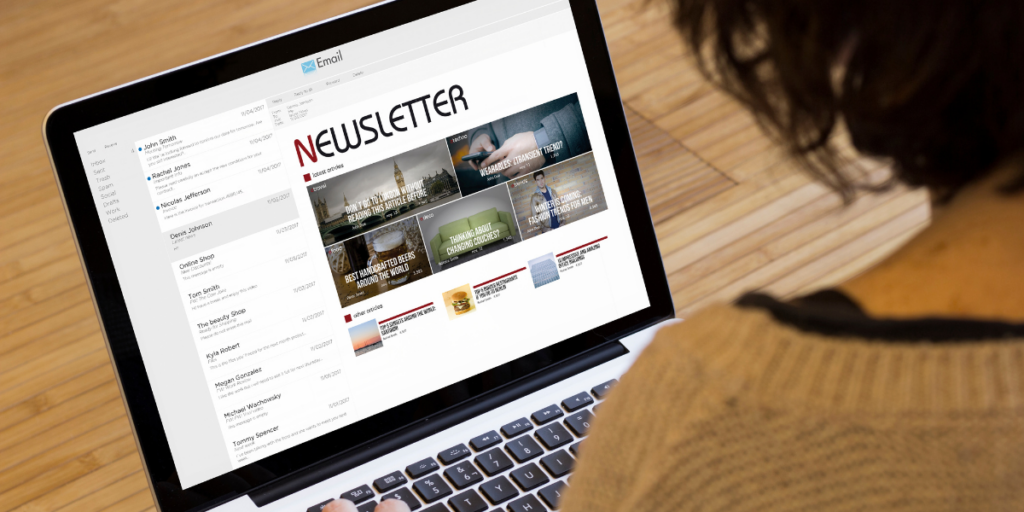Both email marketing and storytelling through content are powerful marketing tools. Email newsletters bring those two things together.
Those that sign-up to your email list are a great group to target as they’ve actively shown an interest in your brand. While you’ll want to send them information about new products, products that they might like, and special discounts and promotions, that shouldn’t be the bulk of your email marketing promotions.
Sending too much sales-driven content is likely to annoy subscribers, especially if you send these emails frequently. This is where email newsletters come in.
Email newsletters allow you to keep in touch with your audience and provide them with useful, informative, and entertaining content. Providing this type of content keeps your brand top of mind and helps build a relationship with your customers (or potential customers) without being too salesy.
If you want to add newsletters to your marketing promotions, keep reading for our beginner’s guide to email newsletters to help understand all their benefits and how to set up your own campaigns.
What Are Email Newsletters?
Email newsletters are a type of email sent by businesses to their list of email subscribers. Newsletters contain valuable information and are based around organic content instead of being product or service-driven and overly sales-based.
Newsletters often include links to content such as blog posts or videos. They may also include other content like company news, tips and tricks, guides, or product reviews and testimonials.
Do remember that those on your email list should have opted-in to receive emails, including newsletters, from you.
Why Use Email Newsletters?
Email newsletters are a great medium to include in your email marketing toolkit. They’re very helpful with lead nurturing and with driving website traffic.
They allow you to share content with an audience that you know is interested in your brand, offerings, and story. In sharing your content, email newsletters also help in driving traffic to your website as that is where the majority of content will be hosted or at least point to.
As newsletters are more organic than sales-based, they allow you to build a relationship with your audience.
You can also include social sharing buttons to help increase the reach of the stories you promote and increase your brand awareness. Along with sharing buttons, you can use newsletters to direct readers to your social media platforms.
Once following you on social, these subscribers will continue to build a relationship with you and be exposed to both organic content and product or service promotions.
Like all forms of email marketing, newsletters are low cost to produce and distribute but can bring a high return. You can also reach 100% of those on your list which isn’t the case with other mediums such as using social media.
However, certain tactics need to be undertaken to ensure the email lands in the inbox of all those on your list and not in their junk folder. Additionally, only an average of around 15% to 25% will open the email once in their inbox but the potential for more to open it is there.

Disadvantages of Email Newsletters
Like with all other types of email, your newsletters will be competing with a lot in each subscriber’s inbox.
You’ll be competing with the content of other brands as well as personal emails that will often be seen as most important by the email user. It’s also easy to quickly delete an email or it may even go to spam.
Building an Email Newsletter List
For all your email marketing promotions to be effective, you’ll need a list of email subscribers. There are many ways to build this list. Promoting your newsletter as an easy way to get content straight to their inbox is a good way to build your list.
Another common technique for getting email list subscribers is using lead magnets. This is when something valuable is offered in exchange for signing up to your email list. Lead magnets can include offering access to an eBook, white paper, checklist, or other valuable resources.
Offering value via a newsletter can be enough of a magnet too to get people to sign-up. Other ways to promote your newsletter include via social media posts and on your website.
Some places to promote your newsletter on your website include:
- On a newsletter landing page
- In the header, footer, or sidebar of your homepage and other pages
- Within content, for example, in the middle of or at the end of a blog post
In a pop-up box that appears after the user has been on your website a certain amount of time (30 seconds to one minute is recommended)
If you plan on sending a few types of newsletters, then ask those on your list (and those signing up to your list) to choose the ones they’d like to receive. This will get the best results once newsletters are sent as they are only being sent to those interested in the content.

Creating Email Newsletters
Once you understand what newsletters are and their importance to your email marketing promotions, you can begin creating newsletters to send to your email list.
Newsletter Strategy
Before creating and sending your email newsletters, you’ll need to plan a strategy for your promotions. Some things to consider include:
Your Audience
You may end up sending your newsletter to all those on your list. However, you may also want to segment your list and send different newsletters to each group.
You can either segment the list yourself using other information you have on the individuals. Or, ask those who sign-up to your list to choose the newsletters they want to receive.
By segmenting themselves, it will be more likely that they’ll enjoy the content in the emails they receive and act on any CTAs you use.
Whether you have one type of newsletter or multiple types, you’ll also need to understand your target audience to ensure the content you choose to send them and the design of your newsletters appeals.
Decide on a Schedule
You’re going to want to create a schedule for sending newsletters too. Decide how many you’ll send a week or month to begin. You’ll also want to determine the best time to send the newsletters.
Many email service providers will provide a suggestion on the optimal send time. Or, you can test this using A/B testing with two different send times and by analyzing results after sending at different times.
Once you’ve determined the optimal sending time, try to send at the same time or at least on the same day each week.
Set Goals
As with all marketing activities, be sure to set goals for your newsletters. While you may have some basic email marketing goals such as a desired open and click-through rate, think as well about exactly what you want to get out of the newsletters.
Unlike other emails that are likely promoting an offer so achieving a certain number of conversions will be a main goal, you aren’t necessarily promoting something to buy in a newsletter.
Common goals along with achieving a certain amount of click-through on each piece of promoted content include getting a certain number of social shares.
You may also want to analyze changes in website traffic due to promotion in a newsletter (analyze traffic before the share and 24 hours after) with a desired outcome for that. For example, you may want to see traffic to the article or your website as a whole increase by 10% after sending.

A/B Testing
To get the best results from your email newsletters, you’ll want to be testing them before you sending to your whole list. This is done through A/B testing, also called split testing.
A/B testing allows you to send two variations of your newsletter to a sample of your email list. The variations in each newsletter should just focus on one element.
For example, you could test two different subject lines, two different designs, or two different CTAs, among many other things.
Once the emails have been sent, you’ll be informed by your email service provider which email had the most success (most opens, most clicks, etc.) You can then send that email to your whole list or test a different element.
Double Opt-In and Whitelisting
Two things you’ll want to consider with new sign-ups to your email list are using double opt-in and getting them to whitelist you.
Double opt-in is when you send an email after they provide their email address asking them to confirm the sign-up. This ensures that those on your email list really want to be on it making it more likely that they’ll open your emails and act on what’s promoted.
You can also use this initial email to request that recipients whitelist you. Whitelisting is when they add you to their address book or list of verified senders. This helps ensure that your newsletters and any other emails you send don’t go to their junk/spam folder.

Email Newsletter Content
As discussed, newsletters focus a lot on organic content. Email is a great platform to promote new products, special offers, and other content directly aimed at generating sales. However, you should also be sharing content that is more informative and entertaining than very sales-based.
There are many things that you can include in newsletters to help educate and entertain your subscribers and build a relationship with them.
The following are some types of content that you could include:
- Shares of blog posts, video, and/or podcasts
- Shares of company news
- Infographics
- Interviews with or spotlights on company employees
- Positive customer feedback, testimonials, and case studies
- Shares of free resources such as white papers or e-books
- Information on upcoming events
- Updates on or news from your social media channels
- Surveys and polls
- Quick tips and tricks, or lists
Headline and Subheadings
The headline (which will be your subject line) and subheading you use are very important to your newsletter’s success. This is what will encourage subscribers to open the email and read the content. If you can’t get subscribers to open your newsletter then all other efforts are wasted.
Your headline should be short and to the point. Aim for a headline that uses ten words at most. It should promote the most interesting story from your newsletter.
Always make sure that the headline (and subheading if used) accurately represent what is in your newsletter. If this isn’t the case, then your open rate may be high but click-through rate will be low as subscribers didn’t receive what was promised once the newsletter was opened.
Subheadings are a good way to promote other stories in the newsletter or to expand a little on your headline. If it doesn’t add value, however, leave out a subheading.

Email Newsletter Design
Along with needing to have content that appeals to your audience, your design needs to be attractive to them too.
If your newsletter is cluttered or uses fonts, colors, and/or images that don’t match your brand and audience preferences, then your message may be ignored and your unsubscribe rate will be high.
For the best results, keep your design clean and simple and use your brand colors and fonts.
Newsletter Layout
The layout of your newsletter greatly depends on your audience and the content being promoted.
If promoting new content like blog posts, many opt for a list type layout with a relevant image and short copy that briefly explains the content and encourages click-through.
Remember to consider content hierarchy when using this type of layout. Place your most interesting story at the top. This may be the most “newsworthy” story or the one that currently gets the most traffic/engagement.
It can be tempting to simply put the story you want to be seen most at the top. But if it isn’t the most appealing of the content being shared then you risk subscribers closing the newsletter straight away.
Other content, such as a “Tips and Tricks” email will highlight the top points (for example, your top five tips briefly outlined in a list) with a link to a relevant piece of content at the end of the newsletter.
Whichever layout you choose, try to be consistent, keeping the same layout for each newsletter you send. You can test different layouts when you begin and then at intervals, however, don’t be constantly changing your layout.
Try to keep consistencies between each type of newsletter too. For example, with the two content types listed above, blog shares and tips and tricks, they will have a different layout but should use the same colors and fonts to keep consistency. Using one header with your company logo on every newsletter will help with this as well.
Email Templates
To help with the layout of your newsletter, email marketing software offers many templates to choose from. There are different templates for different types of content.
Most email marketing software also offers drag and drop templates so you can easily edit the set templates. You can also upload your own HTML if you want to use a design you (or your graphic designer) created.
Email Footer
Make sure you use the footer section of the newsletter too. This is a great place to put general content that subscribers may be looking for.
Things to include in your footer include a link to your website’s homepage, contact information, and links to your social media accounts.
This is also where you can place an unsubscribe button which is necessary to include in every email newsletter you send.

Mobile-Friendly Design
More and more individuals are consuming web content on their mobiles and this includes email. Approximately half of emails are opened on a mobile device.
Therefore, your design needs to be optimized to look good and function correctly on desktop and mobile.
Most email service providers offer a mobile view to check how your design will look on mobile and you should send a test to your own mobile device before sending to check the email looks and functions as it should.
From email campaigns to social media, content calendars can help you get organized, stay organized, be more consistent, and more engaging. Learn How to Create a Social Media Content Calendar in this blog article.
Email Newsletter Scheduling
Automation is a big part of email marketing strategy, especially for workflow email campaigns such as abandoned cart emails or win-back emails. You can also automate your email newsletters.
When automating newsletters, you’ll mainly be wanting to set them for scheduled times. Doing this allows you to send the email at the most optimal time, even if you’re not in the office or are busy at that time.
Scheduling also allows you to set up emails in advance which helps ensure newsletters are ready to go on consistently.
Email Newsletter Analysis
Analyzing results after sending is crucial to the success of your newsletters. The main metrics to analyze are open rate, click-through rate, and unsubscribe rate.
You should also analyze deliverability and if using tracking links, you’ll be able to go further, seeing what readers did after clicking on your links.
Open Rate
Open rate is the percent of subscribers that opened your newsletter. A low open rate indicates that the headline used and/or the content promoted in the headline was not appealing enough to get viewers to read the newsletter.
Having a good open rate is highly important as it doesn’t matter how great the content
in the newsletter is, nobody will see it if you can’t grab them with your headline and convince them to open it.
If your open rate is low, try testing a range of headlines or changing the content you include. The average email open rate is 15-25% but will vary by industry.
Click-Through Rate
Click-through rate is the number of people that opened your newsletter and clicked through on the links you included in it.
Along with overall CTR, you can analyze the click-through rate for each link you included. This can help in showing which call-to-action (CTA) was most effective and which content was most appealing if you included multiple stories in your newsletter.
A low click-through rate indicates that readers were not interested in the content once they got to the newsletter or your CTAs were not effective. It may also be due to the content provided not matching what was promised in the headline/ subject line.
You should be aiming for a click-through rate of between 2.5-5%.
Unsubscribes
Every time you send a newsletter or other email, you’re likely to get some unsubscribes (the average unsubscribe rate is 0.1% per email sent). While getting a few unsubscribes isn’t too much to worry about, do check your unsubscribe rate each time you send newsletters.
If you see that a newsletter got an unusually high unsubscribe rate, analyze the content to see what may have caused it.
If your unsubscribe rate is consistently high, you’ll need to adjust your newsletter strategy completely as your message and content are not appealing to your subscribers.
Deliverability
Deliverability is a measure of how many emails were effectively delivered to your subscribers’ inboxes.
If your deliverability is not at close to 100% then it means that a lot of emails are bouncing and going into spam filters.
Improve deliverability by “cleaning” your email list to remove those that are not interested in your emails or do not see them (indicating they go to spam) and to remove emails that are no longer active.
Tracking Links
If you’re interested in what your email subscribers do once they’ve clicked a link in your newsletter and arrived on the promoted web page, then you’ll want to use tracking links.
You can then analyze where people go and what they do once clicked on a link. If they aren’t doing what you’d like then think about adjusting your CTAs both in the newsletter and on the landing page to lead them where you want.

Email Marketing Software
If you plan to send newsletters (or set up any type of email marketing campaigns), it’s a good idea to use an email marketing software.
This software will offer newsletter templates, will store and manage your email list, allow you to schedule emails, and provide analytics information and optimization advice, among many other things.
There are many options on the market with MailChimp being both a popular choice and easy to use for beginners.
In Conclusion
Email newsletters are a great medium for building relationships with your audience. They help to keep them educated on your offerings and up to date on company news.
Additionally, they are effective in driving website traffic, directing those on your email list to your social media platforms, and keeping them updated on events. Seeing as newsletter creation is very low cost too, they are a must-have tool in your marketing mix.
If you want to add email newsletters to your promotions or create a complete email marketing strategy, Brand Hause can help.
We offer email marketing services from strategy development to implementation of campaigns and analysis of results. We can also help create content to send your email subscribers.
Get in touch today for a free email marketing consultation!

Ready to start harnessing the power of email marketing? Let Brand Hause create engaging emails that will boost your revenue and help you build meaningful relationships with your customers.







